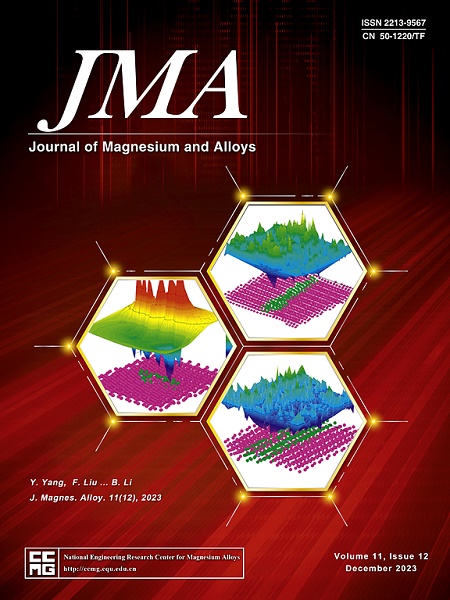A quasi-in-situ EBSD study on mechanical response and twin variant selection of a hot-rolled AZ31 magnesium alloy
IF 15.8
1区 材料科学
Q1 METALLURGY & METALLURGICAL ENGINEERING
引用次数: 0
Abstract
The selection of twin variants plays a critical role in shaping the deformation texture and mechanical properties of magnesium alloys that are limited by slip systems and diverse twinning modes. In this study, we investigated the twin variant selection and the effect of twinning activity on the strain hardening of a hot-rolled AZ31 magnesium alloy by quasi-in-situ EBSD. Moreover, the Schmid factors and the displacement gradient tensors were computed to evaluate the activation of twin variants. The results reveal that the yield strength increased progressively after each deformation step, driven by grain subdivision and texture hardening induced by extension twinning and the Basinski effect at large strains. The nucleation and growth of the twins occurred either sequentially or simultaneously during the plastic deformation. At low plastic strains, the activation of most twin variants followed the high Schmid factor criterion while the other twin variants with lower Schmid factors were activated due to the interactions with preexisting twins characterized by high misorientation angles (around 60°). Additionally, this non-Schmid factor scenario was also attributed to low coordinated strain requirements from neighboring grains, showing the critical role of local deformation accommodation in the twinning process. These findings advance the fundamental understanding of the twin variant selection and its implications for the microstructure-property relationship in magnesium alloys for structural applications.


热轧AZ31镁合金力学响应及双晶型选择的准原位EBSD研究
镁合金受滑移系统和不同孪晶模式的限制,孪晶变体的选择对镁合金的形变织构和力学性能的形成起着至关重要的作用。本研究采用准原位EBSD法研究了孪晶变异选择和孪晶活性对热轧AZ31镁合金应变硬化的影响。此外,计算了施密德因子和位移梯度张量来评估双变体的激活。结果表明:由于{101¯2}{101¯2}孪晶和大应变下的Basinski效应引起的晶粒细化和织构硬化,合金的屈服强度在每一步变形后逐渐提高;{101¯2}{101¯2}孪晶在塑性变形过程中依次或同时形核和长大。在低塑性应变下,大多数双胞变体的激活遵循高施密德因子标准,而其他具有低施密德因子的双胞变体由于与先前存在的双胞的相互作用而被激活,这些双胞变体的特征是高取向角(约60°)。此外,这种非施密德因子情景也归因于邻近晶粒的低协调应变要求,显示了局部变形调节在孪生过程中的关键作用。这些发现促进了对双变体选择的基本理解及其对镁合金结构应用中的显微组织-性能关系的影响。
本文章由计算机程序翻译,如有差异,请以英文原文为准。
求助全文
约1分钟内获得全文
求助全文
来源期刊

Journal of Magnesium and Alloys
Engineering-Mechanics of Materials
CiteScore
20.20
自引率
14.80%
发文量
52
审稿时长
59 days
期刊介绍:
The Journal of Magnesium and Alloys serves as a global platform for both theoretical and experimental studies in magnesium science and engineering. It welcomes submissions investigating various scientific and engineering factors impacting the metallurgy, processing, microstructure, properties, and applications of magnesium and alloys. The journal covers all aspects of magnesium and alloy research, including raw materials, alloy casting, extrusion and deformation, corrosion and surface treatment, joining and machining, simulation and modeling, microstructure evolution and mechanical properties, new alloy development, magnesium-based composites, bio-materials and energy materials, applications, and recycling.
 求助内容:
求助内容: 应助结果提醒方式:
应助结果提醒方式:


